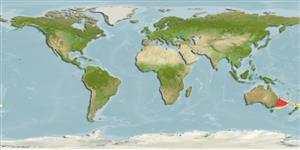Elasmobranchii (tubarões e raias) (sharks and rays) >
Carcharhiniformes (Ground sharks) >
Scyliorhinidae (Cat sharks) > Scyliorhininae
Etymology: Cephaloscyllium: cephalus, from kephale (Gr.), head, referring to its very broad and depressed head; skylion, Greek for dogfish or small shark (See ETYFish); variegatum: Latin for varied or various, referring to strong intraspecific and ontogenetic variability in color pattern and morphology amongst the specimens examined (See ETYFish).
More on authors: Last & White.
Environment: milieu / climate zone / depth range / distribution range
Ecologia
marinhas batipelágico; intervalo de profundidade 114 - 606 m (Ref. 76948). Subtropical
Southwest Pacific: Australia.
Length at first maturity / Tamanho / Peso / Idade
Maturity: Lm ?, range 63 - ? cm
Max length : 72.0 cm TL macho/indeterminado; (Ref. 76948); 74.0 cm TL (female)
Descrição breve
Chaves de identificação | Morfologia | Morfometria
This medium-sized species is distinguished by the following set of characters: head 9.4-10.5% TL in height, trunk width 14.5-17.1% TL; origin of first dorsal fin over or slightly behind mid pelvic-fin base; prenarial 4.4-5.0% TL in length; length of preorbital snout, 1.5-1.7 times prenarial length, 2.9-3.3 in prepectoral length, 6.4-7.2 in prepelvic length; snout-vent length long, 50.5-52.9% TL; nostril 2.4-2.6% TL in width; eye-spiracle space wide, 0.8-1.3% TL; pectoral fin large, height 12.9-13.2% TL, posterior margin length 10.4-12.1% TL; anal fin 3.5-4.1% TL in height; anal-caudal space 4.5-5.7% SL; precaudal 76-78% TL in length; interdorsal space 6.5-8.0% TL; teeth with 3-7 cusps near symphysis of upper jaw; flank denticles are mainly unicuspidate; back with no greatly enlarged denticles; long adult clasper, up to 8.1% TL, almost reaching anal fin, interspace about 5.4 in anal-fin base; vertebral centra 116-124; teeth in each jaw 68-82; variable colour pattern, not similar between adults and juveniles; adults have 11 distinct or indistinct dark saddle-like markings on body and tail while juveniles are without saddles, instead with fine blackish spots; predorsal saddles are not much wider than interspaces between them; interspiracular saddle width is subequal to eye length; obvious dark blotch over gill slits none; fleshy part of caudal fin appearing as a pale stripe, well demarcated from darker areas above and below (Ref. 76948).
Life cycle and mating behavior
Maturidade | Reprodução | Desova | Ovos | Fecundidade | Larvas
Last, P.R. and W.T. White, 2008. Two new saddled swellsharks (Cephaloscyllium: Scyliorhinidae) from Eastern Australia. In Last, P.R., White, W.T. & Pogonoski, J.J. (eds.): Descriptions of New Australian Chondrichthyans. CSIRO Marine and Atmospheric Research Paper no. 22. (Ref. 76948)
Categoria na Lista Vermelha da IUCN (Ref. 130435: Version 2024-2)
Ameaça para o homem
Harmless
Utilização humana
Ferramentas
Relatórios especiais
Descarregue XML
Fontes da internet
Estimates based on models
Preferred temperature (Ref.
123201): 12 - 17.7, mean 13.8 °C (based on 13 cells).
Phylogenetic diversity index (Ref.
82804): PD
50 = 0.5000 [Uniqueness, from 0.5 = low to 2.0 = high].
Bayesian length-weight: a=0.00263 (0.00138 - 0.00502), b=3.21 (3.04 - 3.38), in cm total length, based on LWR estimates for this (Sub)family-body shape (Ref.
93245).
Nível Trófico (Ref.
69278): 4.1 ±0.5 se; based on size and trophs of closest relatives
Resiliência (Ref.
120179): Baixo, tempo mínimo de duplicação da população 4,5 - 14 anos (Preliminary K or Fecundity.).
Fishing Vulnerability (Ref.
59153): Moderate to high vulnerability (50 of 100).
